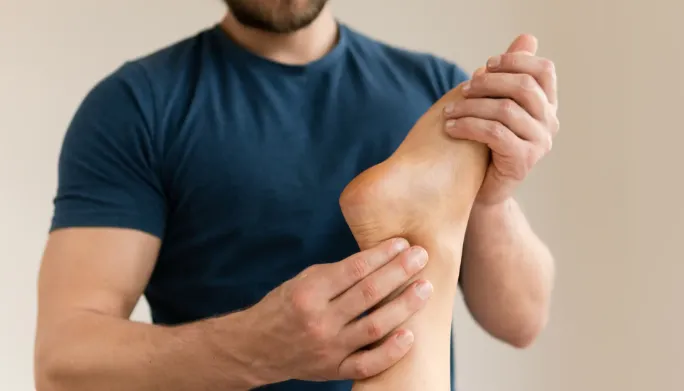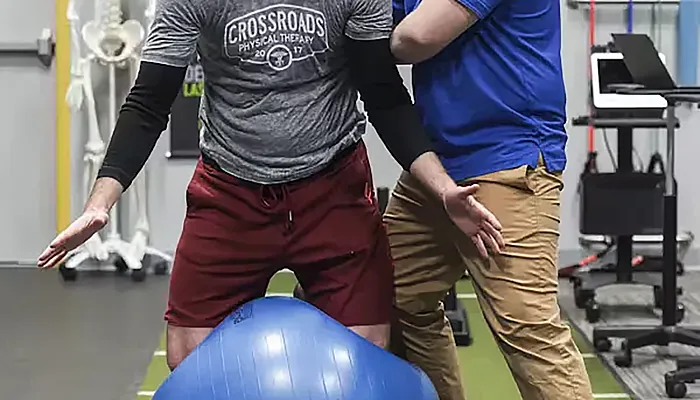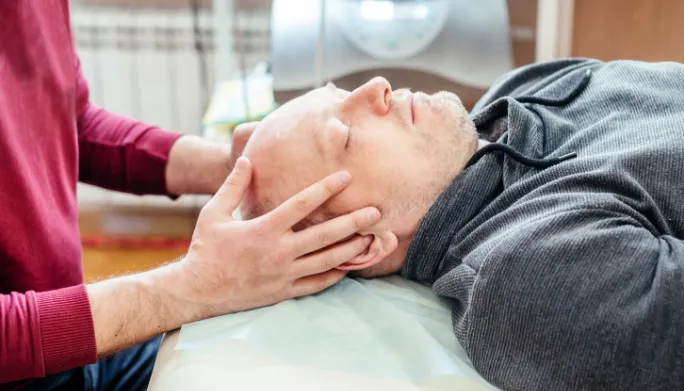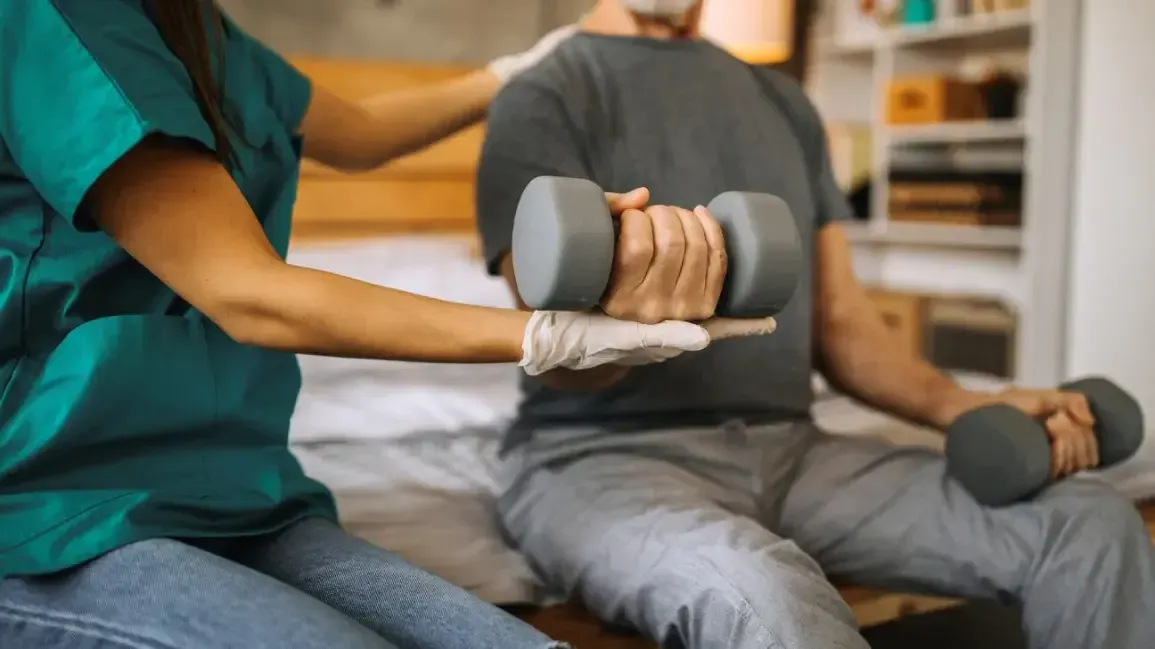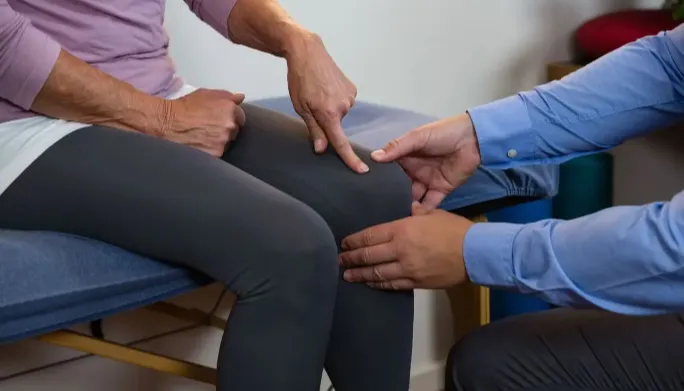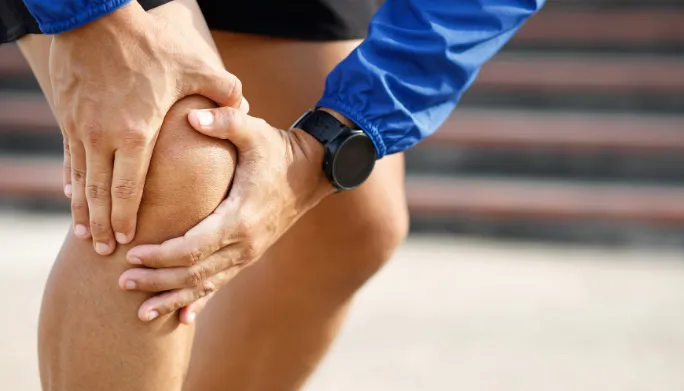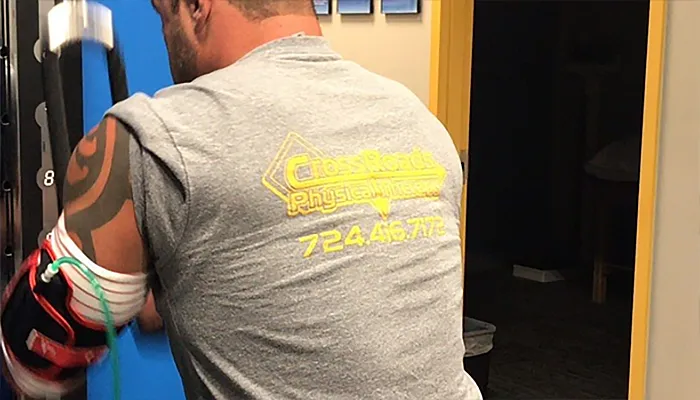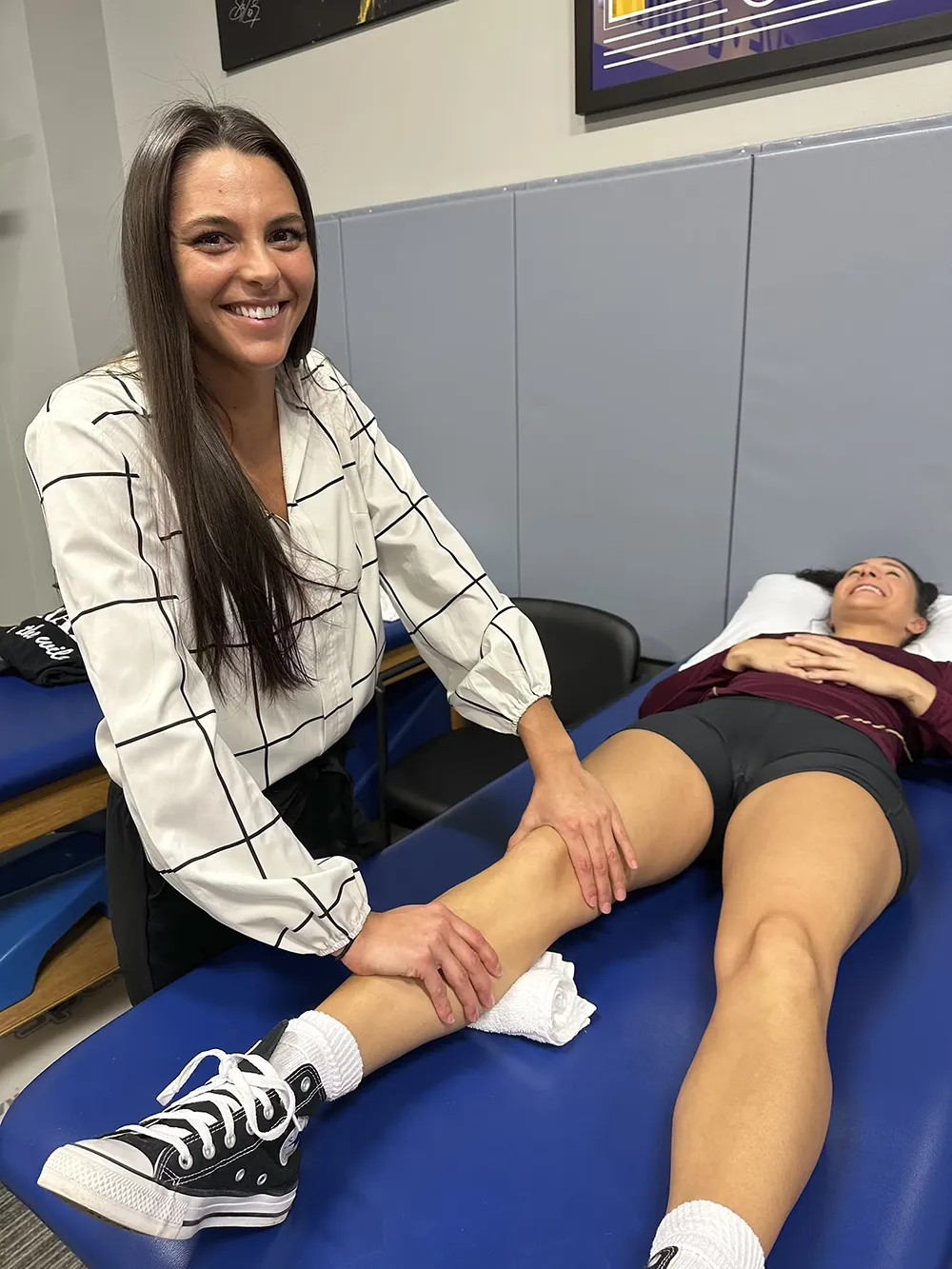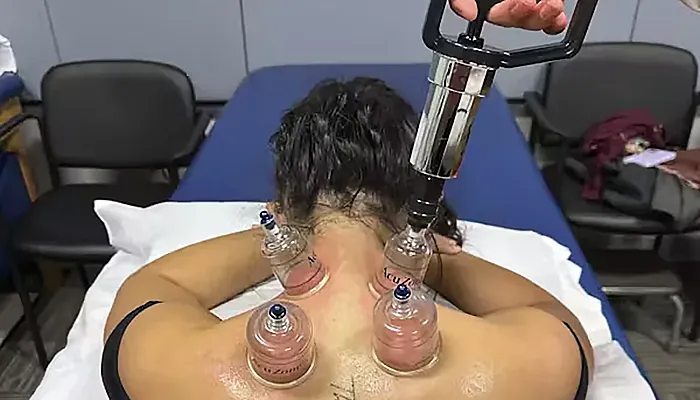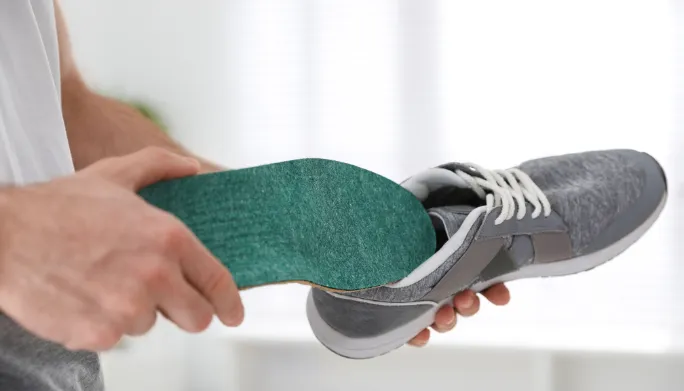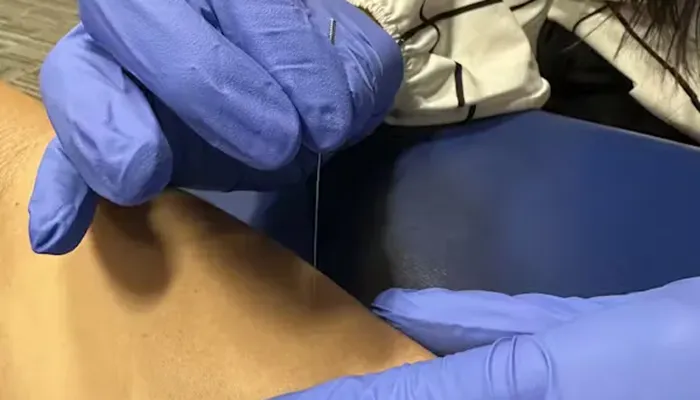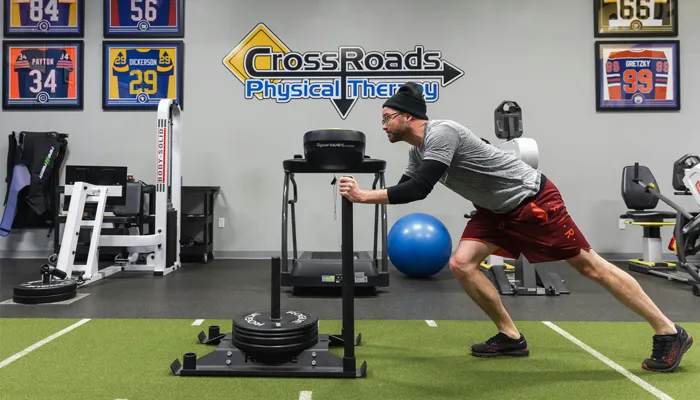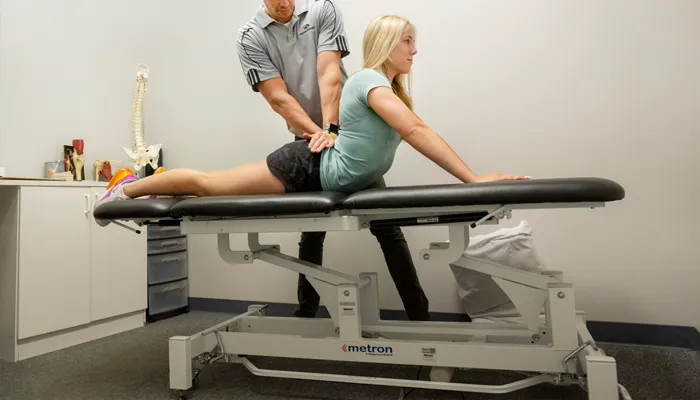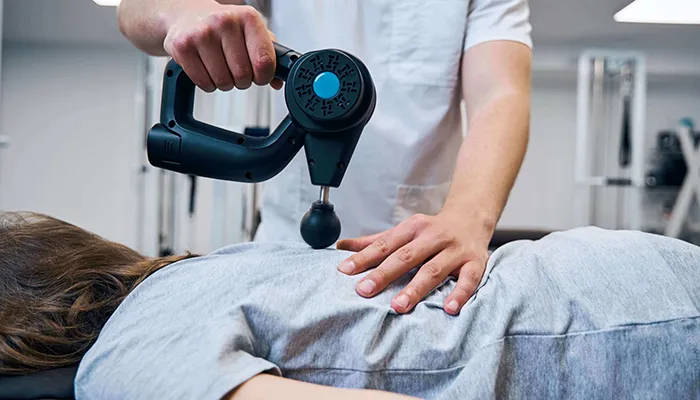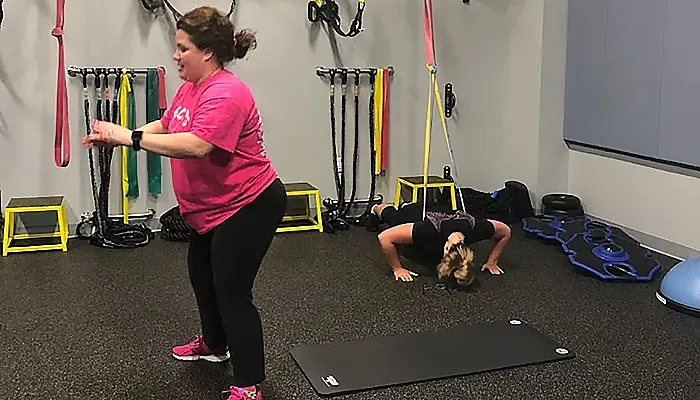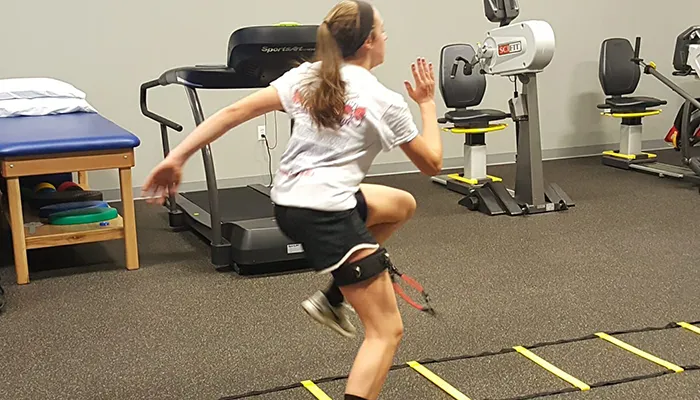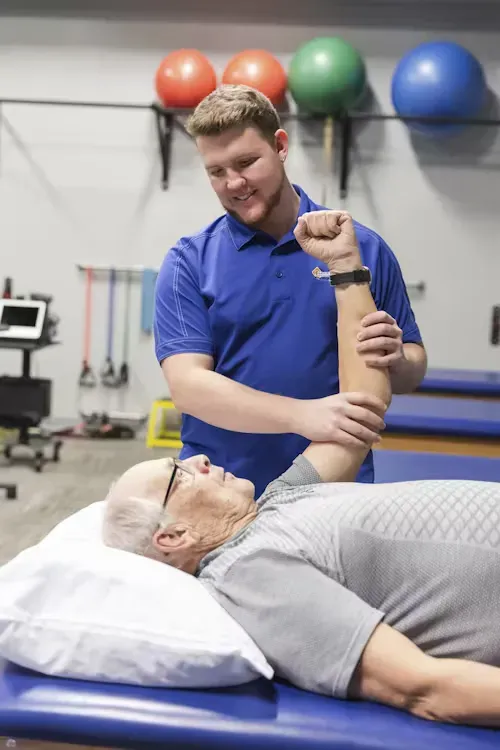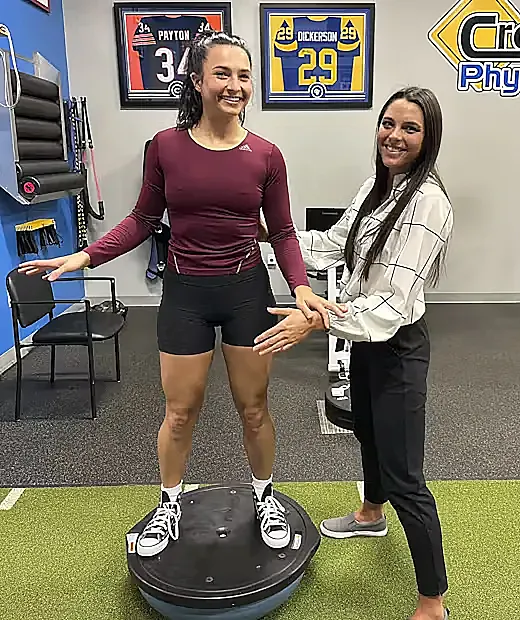Washington, PA
900 Wildflower Cir #903, Washington, PA 15301
P: (724) 416-7172
F: (724) 416-3037
admin@crphysicaltherapy.com
Wheeling, WV
1086 E Bethlehem Blvd, Wheeling, WV 26003
P: (304) 238-9468
F: (304) 238-9472
admin@crphysicaltherapy.com
Physical Therapy in Washington, PA
Expert Physical Therapy for Rapid Pain Relief
We help you regain strength and mobility, so you can return to the activities that matter most to you.

5-Star Google Rating
We are proud to have a 5-star Google rating! This demonstrates our commitment to excellent service and hopefully builds trust with new customers!

Over 120 5-Star Reviews
We are thrilled to have received so many 5-star Google ratings for our outstanding contributions and exceptional service to our community.

Facebook 5-Star Rating
Our Facebook 5-star rating is a testament to our exceptional service and commitment to customer satisfaction. Thank you for your continued support!
Top Rated Physical Therapists in Washington, PA
At CrossRoads Physical Therapy, we offer more than just treatment—we provide personalized care that gets to the root of your pain. Our highly trained, licensed team specializes in dry needling and hands-on therapy to help you recover quickly and get back to doing what you love. You can count on our compassionate, results-driven approach to keep you moving without relying on medications or surgery.
We believe every patient deserves a tailored plan designed for their unique needs and goals. Along with expert care, we empower you with the tools and education to stay healthy, prevent future injuries, and thrive long-term.
Conditions We Treat
Personalized Care From Our Team
At CrossRoads Physical Therapy, we understand that no two bodies—or injuries—are alike. Even if the pain affects the same area, your recovery plan should be as unique as you are. Our expert team carefully assesses your condition to craft a treatment plan tailored to your specific needs and goals, ensuring you get back to the activities you love. Every visit is guided by our personalized, one-on-one approach, providing the care and attention you deserve.
Our Proven 5-Phase Recovery Program
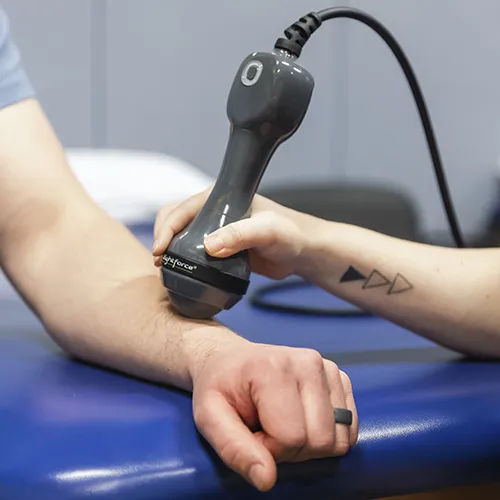
Pain Relief
The first step to recovery focuses on easing pain, swelling, and inflammation. To kick-start healing, we utilize a combination of techniques such as elevation, compression, and deep tissue laser therapy. Laser therapy works by penetrating deep into the tissues, reducing inflammation and stimulating cellular repair, which accelerates the healing process and provides quicker pain relief. Our team also educates you on how to manage discomfort effectively at home, using strategies and tools that empower you to take control of your recovery from the very start.
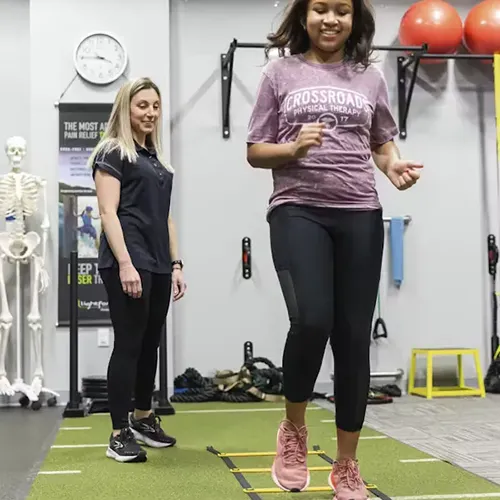
Introduce Movement
Once your pain is under control, we introduce safe and controlled movement in Phase 2. This involves gentle, pain-free passive and active range-of-motion exercises, along with manual therapy techniques that help restore your mobility without causing discomfort. Cardiorespiratory exercises are also integrated at this stage to maintain overall health and stamina, ensuring your cardiovascular system stays strong while your body heals. We emphasize the importance of maintaining a positive mindset and staying motivated, educating you on how movement aids recovery and reduces the likelihood of setbacks.
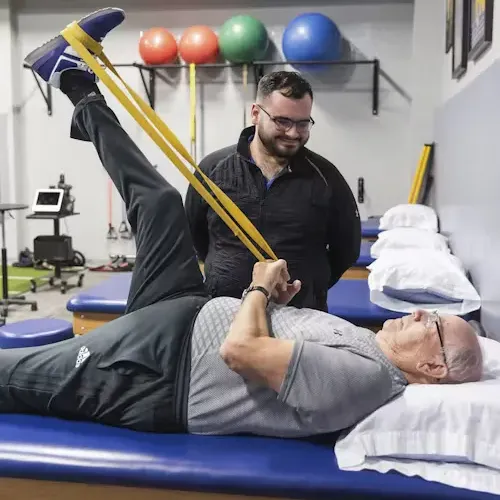
Strengthening
With mobility restored, Phase 3 focuses on rebuilding strength and stability through targeted therapeutic exercises. These exercises progressively load the healing tissues, improving muscle strength, joint stability, and coordination. We incorporate neuromuscular reeducation to help retrain your body’s movement patterns, along with balance exercises to improve stability. This phase is essential for helping you regain the strength and confidence needed to return to your normal activities. Therapeutic exercises are tailored to your specific needs, ensuring you make steady progress without overloading your recovering body.
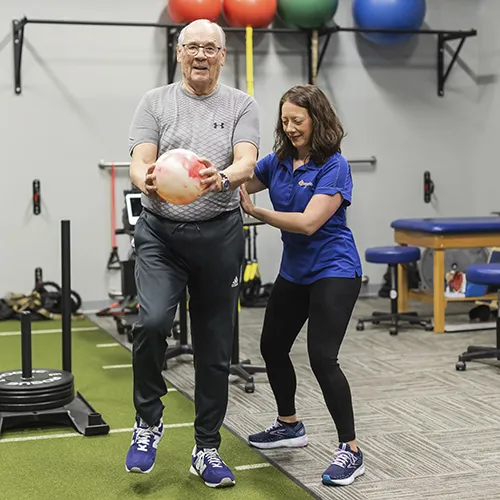
Functional Retraining
Phase 4 moves beyond basic strengthening and focuses on preparing your body for the demands of daily life and any sports or activities you enjoy. Advanced balance exercises help improve your stability, coordination, and flexibility, while functional training incorporates movements that mimic real-life tasks and athletic activities. Whether you’re an athlete aiming to return to your sport or simply want to perform daily tasks pain-free, we design this phase to ensure you regain full function. This stage is all about refining your movement and building the strength and resilience you need to perform at your best, in both life and sport.
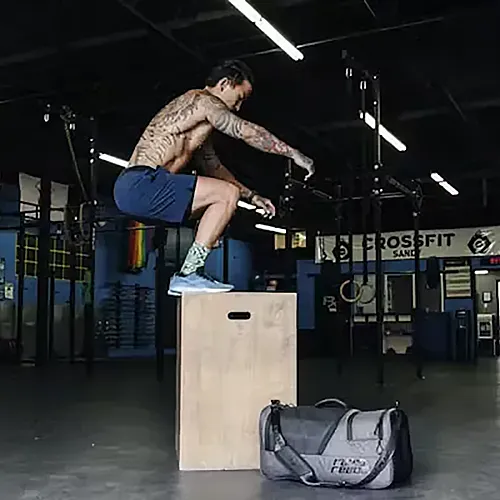
Recovery and Prevention
The final phase of recovery is dedicated to solidifying your progress and equipping you with the tools to stay injury-free. We introduce advanced functional movements, sports-specific training, and carefully controlled exposure to challenging environments—whether that’s a sports field, gym, or workplace. This phase ensures that your body is ready to handle the physical demands of your life, whether it’s competing in a sport or simply staying active. We’ll also provide comprehensive education on injury prevention, teaching you how to maintain your progress and avoid future setbacks. Our goal is to help you stay strong, healthy, and pain-free well beyond your time in therapy.
Success Stories & Testimonials
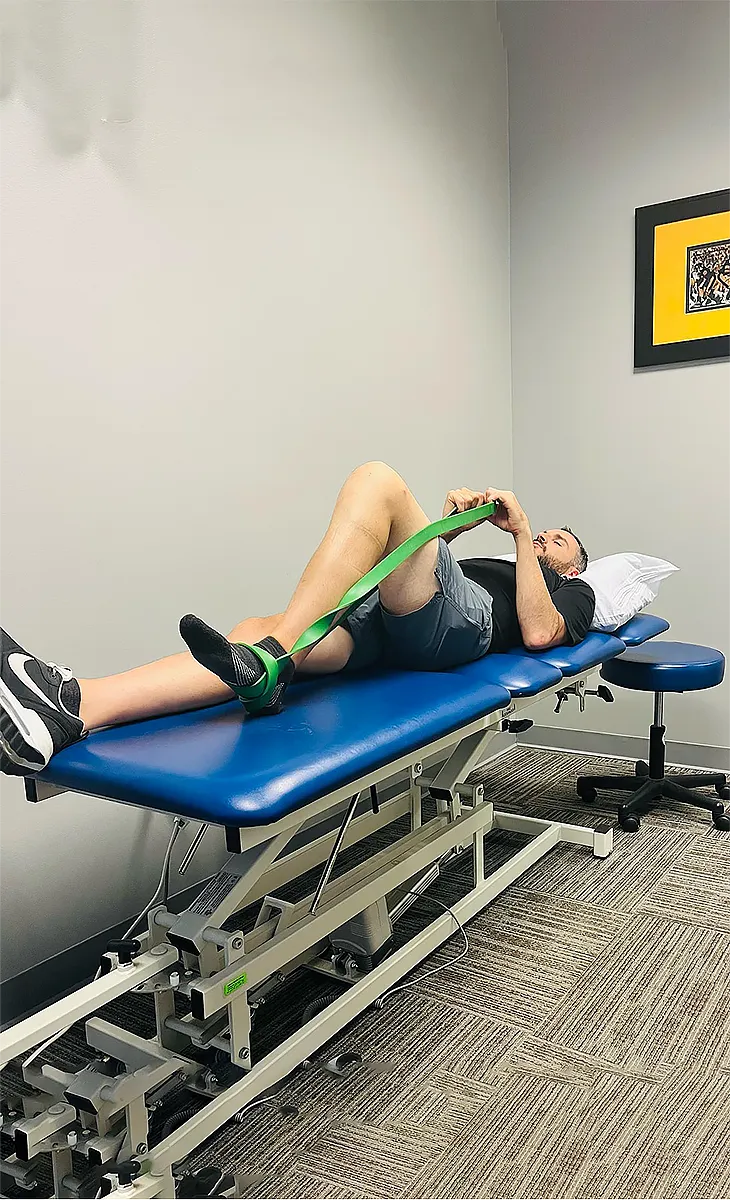
Meet Our Team
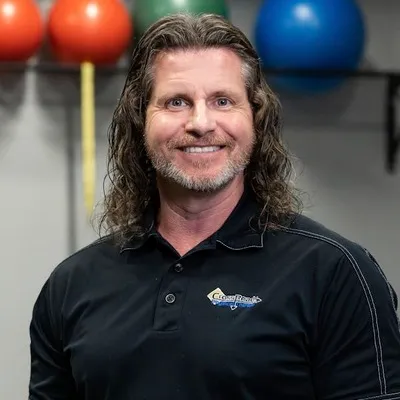
Dr. Kevin Perris
DPT, PT
Owner, Physical Therapist
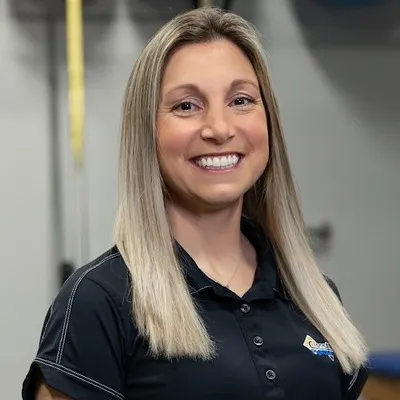
Dr. Kara C. Jewell-Welling
PT, DPT
Physical Therapist
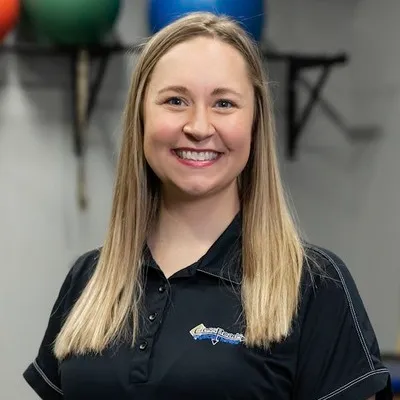
Staci Sengewalt
PT
Physical Therapist
Why You Should Consider Us Over Corporate Clinics or Hospitals:
| Feature |
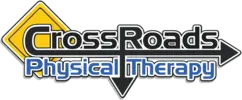
|
CORPORATE | HOSPITAL |
|---|---|---|---|
| Immediate Appointments Available | ✅ | ❌ | ❌ |
| Warm, Family-Friendly Clinic Serving the Area Since 2017 | ✅ | ❌ | ❌ |
| One-on-One Treatment with Your Therapist | ✅ | ❌ | ❌ |
| Neck, Back, Shoulder, Knee Specialists | ✅ | ❌ | ❌ |
| Vestibular Rehabilitation Experts | ✅ | ❌ | ❌ |
| Pelvic Floor Therapy | ✅ | ❌ | ❌ |
| Dry Needling | ✅ | ❌ | ❌ |
| Custom Orthotics | ✅ | ❌ | ❌ |
| Deep Tissue Laser Therapy | ✅ | ❌ | ❌ |
| Blood Flow Restriction Therapy | ✅ | ❌ | ❌ |
| Rapid Reboot Compression | ✅ | ❌ | ❌ |
| IASTM - Instrument Assisted Soft Tissue Mobilization | ✅ | ❌ | ❌ |
| Free Discovery Visit | ✅ | ❌ | ❌ |
| Rapid Reboot Compression | ✅ | ❌ | ❌ |
Treatments
Cupping
If chronic injuries, inflammation, or muscular tension has you feeling less than your best, exploring cupping therapy with CrossRoads Physical Therapy can help get you back on track.
Read More
Custom Orthotics
Are you struggling with foot pain, discomfort, or mobility issues? Imagine walking, running, and living your life without the constant nagging pain in your feet. At CrossRoads Physical..
Read More
Dry Needling
If unrelenting muscle tension, restricted mobility from past injuries, or unresolved neurological and movement dysfunction has you struggling to perform basic tasks pain-free, exploring dry needling..
Read More
Physical Therapy
From weekend warriors dealing with nagging pain to aging adults hoping to remain independent, patients choose CrossRoads Physical Therapy for customized physical therapy..
Read More
Sports Rehab
Is your game stalled by injury or just not measuring up anymore due to mobility restrictions or strength deficits? Let CrossRoads Physical Therapy’s sports rehabilitation team help you..
Read More
The McKenzie Method
Are you tired of living with persistent back, neck, or joint pain? Do you long for a solution that doesn’t just mask your symptoms but actually empowers you to manage and overcome your discomfort?
Read More
Theragun
Percussive Massage Therapy, also known as tapotement, is a new breakthrough in treating patients with soft tissue pain. It is a mechanical high-intensity, high-powered massage that provides strong..
Read More
Therapeutic Exercise
Are you tired of living with chronic pain, limited mobility, or recurring injuries? At CrossRoads Physical Therapy in Washington, PA, we understand the frustration and limitations..l
Read More
Young Athlete Services
Are you a young athlete looking to take your performance to the next level? Do you worry about injuries derailing your athletic dreams? At CrossRoads Physical Therapy in Washington, PA..
Read More
Live Pain Free and Active In Washington, PA
At CrossRoads Physical Therapy, we know you want to stay active and live life to the fullest, but pain, injury, or weakness can make that feel impossible. It’s frustrating when your body isn’t working as it should. That’s why we’re here to help.
Here’s how we make it happen:
- Share your story with us.
- Receive a personalized treatment plan.
- Start feeling better and stronger.
- Achieve your goals and get back to what you love.
Testimonials
I’ve had a long physical therapy journey after my knee surgery. I went to a different place before finding Crossroads PT and so far they have challenged me a lot more and I’ve been feeling better. Kevin took a lot of time to listen to what I need to work on and set up a good plan to get my knee back to where it needs to be. I’ve been working with Colton and he’s been very helpful and understanding. I’m optimistic for the future!
Kevin and his staff are miracle workers. I had lower back pain and leg numbness everyday for months. After trying everything but surgery, I made an appointment with Kevin. I immediately felt relief. I would highly recommend and wish I had started with Kevin at the start of my injury. Anyone I have referred to him has had the same experience!
The level of care is exceptional at this facility! Dr Kevin Perris is an intelligent, skilled and compassionate Physical Therapist. I have been to PT at a different location but nothing as effective as this group! The staff is amazing. They are Great Team; using aggressive techniques and healing patients👍After your first visit, One feels like family … they make you feel like they act ….” Caring with Sincere ” concern for your pain.
Comprehensive Physical Therapy Programs Tailored to You
At CrossRoads Physical Therapy, we deliver top-notch physical therapy and personalized training programs designed just for you. Our programs are built to help you reach your health and wellness goals, starting with effective pain management and progressing through corrective exercises to strengthen your body.
Next, we focus on functional training to enhance your mobility and endurance, followed by injury prevention strategies. This final phase ensures you maintain your strength and stay injury-free long after your therapy is complete.
Frequently Asked Questions
What do I need to bring with me?
Make sure you bring your physical therapy referral (provided to you by your doctor) and your payment information. If your insurance is covering the cost of physical therapy, bring your insurance card. If you are covered by Workers’ Compensation, bring your claim number and your case manager’s contact information. If you are covered by auto insurance or an attorney lien, make sure you bring this information.
What happens during my first visit?
During your first visit you can expect the following:
- Arrive at your appointment with your paperwork completed (you can download it from our website – see the paperwork or forms link).
- You will provide us with your referral for physical therapy if you have one. If you don’t have a referral, let us know when you schedule your first visit with us (note – a referral is not always needed).
- We will copy your insurance card.
- You will be seen for the initial evaluation by the therapist.
The therapist will discuss the following:
- Your medical history.
- Your current problems/complaints.
- Pain intensity, what aggravates and eases the problem.
- How this is impacting your daily activities or your functional limitations.
- Your goals with physical therapy.
- Medications, tests, and procedures related to your health.
The therapist will then perform the objective evaluation which may include some of the following:
- Palpation – touching around the area of the pain/problem. This is done to check for the presence of tenderness, swelling, soft tissue integrity, tissue temperature, inflammation, etc.
- Range of Motion (ROM) – the therapist will move the joint(s) to check for the quality of movement and any restrictions.
- Muscle Testing – the therapist may check for strength and the quality of the muscle contraction. Pain and weakness may be noted. Often the muscle strength is graded. This is also part of a neurological screening.
- Neurological Screening – the therapist may check to see how the nerves are communicating with the muscles, sensing touch, pain, vibration, or temperature. Reflexes may be assessed as well.
- Special Tests – the therapist may perform special tests to confirm/rule out the presence of additional problems.
- Posture Assessment – the positions of joints relative to ideal and each other may be assessed.
The therapist will then formulate a list of problems you are having, and how to treat those problems. A plan is subsequently developed with the patient’s input. This includes how many times you should see the therapist per week, how many weeks you will need therapy, home programs, patient education, short-term/long-term goals, and what is expected after discharge from therapy. This plan is created with input from you, your therapist, and your doctor.
How many visits will I need?
This is highly variable. You may need one visit or you may need months of care. It depends on your diagnosis, the severity of your impairments, your past medical history, etc. You will be re-evaluated on a monthly basis and when you see your doctor, we will provide you with a progress report with our recommendations.
What do physical therapists do?
You have probably heard of the profession of physical therapy. Maybe you have spoken with a friend about how physical therapy helped get rid of their back pain, or you might know someone who needed physical therapy after an injury. You might even have been treated by a physical therapist yourself. But have you ever wondered about physical therapists–who they are and what they do? Many people are familiar with physical therapists’ work helping patients with orthopedic problems, such as low back pain or knee surgeries, reduce pain and regain function. Others may be aware of the treatment that physical therapists provide to assist patients recovering from a stroke (e.g., assisting them with recovering using their limbs and walking again).
The ability to maintain an upright posture and to move your arms and legs to perform all sorts of tasks and activities is an important component of your health. Most of us can learn to live with the various medical conditions that we may develop, but only if we can continue at our jobs, take care of our families, and enjoy important occasions with family and friends. All of these activities require the ability to move without difficulty or pain.
Because physical therapists are experts in movement and function, they do not confine their talents to treating people who are ill. Preventing injury, loss of movement, and even surgery is a large part of a physical therapist’s program. Physical therapists work as consultants in industrial settings to improve the design of the workplace and reduce the risk of workers overusing certain muscles or developing low back pain. They also provide sports therapy and sports performance services for athletes of all levels to screen for potential problems and institute preventive exercise programs. With the boom in the golf and fitness industries, several physical therapists provide consulting services for recreational golfers and fitness clubs to develop safe and effective workouts, especially for people who already know that they have a problem with their joints or backs.
The cornerstones of physical therapy treatment are therapeutic exercise and functional training. In addition to “hands-on” care, physical therapists also educate patients to take care of themselves and perform certain exercises independently. Depending on the particular needs, physical therapists may also “mobilize” a joint (that is, perform certain types of movements at the end of your range of motion) or massage a muscle to promote proper movement and function. Physical therapists also use methods such as ultrasound (which uses high-frequency waves to produce heat), hot packs, and ice.
Although other practitioners may offer some of these treatments as “physical therapy,” only qualified physical therapists or physical therapist assistants who must complete a 2-year education program and work only under the direction and supervision of physical therapists can provide physical therapy.
Your insurance will cover most forms of physical therapy treatment, but the coverage will vary with each plan. All 50 states offer direct access to physical therapy, which means that patients are not necessarily required to see their physicians before seeing a physical therapist. In many cases, all you have to do is ask your doctor if physical therapy is right for you. Contact us for more information on direct access.
Reference: APTA
Why should I choose a private practice physical therapist?
Who is better to see, a PT that works for a physician or a PT that owns a private practice? We leave it up to you to draw your own conclusions but here are some facts. The studies indicate there were more treatments (visits per patient were 39% to 45% higher in physician owned clinics) and the cost was greater for those patients that attended a physician owned physical therapy practice (both gross and net revenue per patient were 30% to 40% higher)1.
Another study indicated that licensed and non-licensed therapy providers spent less time with each patient in physician owned clinics and physical therapy assistants were substituted for physical therapists.2
Another older study concluded that “Therapists who had treated patients through direct access were significantly more likely to believe that direct access had benefited them professionally and benefited their patients than were therapists who had not practiced through direct access.”3
We believe that we can provide you with the highest quality of care available and do it in a cost-effective manner.4 You will work closely with your physical therapist and in most instances, your case will be managed by the same physical therapist from the beginning to the end of your experience with us.
- Mitchell, J., Scott, E., Physician Ownership of Physical Therapy Services: Effects on Charges, Utilization, Profits, and Service Characteristics, Journal of the American Medical Association, 1992.
- “Joint Ventures Among Health Care Providers in Florida,” State of Florida Health Care Cost Containment Board, 1991.
- Domholdt E, Durchholz AG. Direct access use by experienced therapists in states with direct access. Phys Ther. 1992 Aug;72(8):569-74.
- Federal Office of the Inspector General May 1, 2006 – This report calls into question billing processes done by non-physical therapist owned practices.
Is physical therapy painful?
For many patients, one of the primary objectives is pain relief. This is frequently accomplished with hands-on techniques, modalities such as ultrasound, electrical stimulation, and/or heat or cold therapy. Movement often provides pain relief as well. Your physical therapist will provide you with the appropriate exercises not only for pain relief but to recover range of motion, strength, and endurance.
In some cases, physical therapy techniques can be painful. For example, recovering knee range of motion after total knee replacement or shoulder range of motion after shoulder surgery may be painful. Your physical therapist will utilize a variety of techniques to help maximize your treatment goals. It is important that you communicate the intensity, frequency, and duration of pain to your therapist. Without this information, it is difficult for the therapist to adjust your treatment plan.
Can I go directly to my physical therapist?
In Pennsylvania, you can see a physical therapist without a physician’s referral thanks to Direct Access. This means you can start your treatment right away, saving time and potentially speeding up your recovery. Our licensed physical therapists in Washington, PA, are equipped to evaluate and treat a wide range of conditions. If your insurance requires a referral or if your condition needs further medical evaluation, we will guide you through the necessary steps. Contact us today to learn more about how Direct Access can benefit you and to schedule your appointment.
All fifty states have some form of direct access. In most cases, if you are not making significant improvement within 30 days, the therapist will refer you to/back to your physician.
Seeing a physical therapist first is safe and could save you hundreds of dollars or even thousands of dollars. Click here for details
What will I have to do after physical therapy?
Some patients will need to continue with home exercises. Some may choose to continue with a gym exercise program. Others will complete their rehabilitation and return to normal daily activities. It is important that you communicate your goals to your therapist, so he/she can develop a custom program for you.
How do I choose a physical therapy clinic?
These are some things you may consider when seeking a physical therapy clinic:
- The therapist should be licensed in the state.
- The first visit should include a thorough medical history and physical examination before any treatment is rendered.
- The patient goals should be discussed in detail during the first visit.
- Care should include a variety of techniques which might include hands-on techniques, soft tissue work, therapeutic exercises and in some cases heat, cold, electrical stimulation or ultrasound.
- Do they have a service that can address your problem?
- Do they take your insurance or are they willing to work with you if they are not a preferred provider?
- They should be conveniently located. Since sitting and driving often aggravate orthopedic problems, there should be a very good reason for you to drive a long distance for rehabilitation.
- What are the hours of operation?
- Can they provide satisfaction survey results?
- The therapist should provide the treatment.
- Can you briefly interview the therapist before the first visit?
- Ask your family and friends who they would recommend.
How should I dress?
You should wear loose-fitting clothing to expose the area that we will be evaluating and treating. For example, if you have a knee problem, it is best to wear shorts. For a shoulder problem, a tank top is a good choice. For low back problems, wear a loose-fitting shirt and pants, again so we can perform a thorough examination.
How long will each treatment last?
Treatment sessions typically last 30 to 60 minutes per visit.
Why is physical therapy a good choice?
More than half of all Americans are suffering from pain. Whether it is a recent episode or chronic, an ABC News/Stanford study revealed that pain in America is a serious problem. However, many do not even know that physical therapists are well equipped to not only treat pain but also its source.
Physical therapists are experts at treating movement and neuro-musculoskeletal disorders. Pain often accompanies a movement disorder, and physical therapists can help correct the disorder and relieve the pain.
Why are people referred to physical therapy?
Your doctor may refer you to physical therapy because of a movement dysfunction associated with pain. Your difficulty with moving part(s) of your body (like bending at the low back or difficulty sleeping on your shoulder, etc.) very likely results in limitations with your daily activities (e.g., difficulty getting out of a chair, an inability to play sports, or trouble with walking, etc.). Physical therapists treat these movement dysfunctions and their associated pains and restore your body’s ability to move in normally.
Who pays for the treatment?
In most cases, health insurance will cover your treatment. Click on our insurance link above for a summary of insurances we accept and make sure you talk to our receptionist so we can help you clarify your insurance coverage.
What types of treatments will I receive?
There are dozens of different types of treatment interventions. Here is a list of treatment interventions:
Active Range of Motion (AROM) – the patient lifts or moves a body part through range of motion against gravity. AROM is usually one of the first modalities prescribed for arthritis.
Active Assistive Range of Motion (AAROM) – therapist-assisted active range of motion. This is usually prescribed for gentle stretching or strengthening for a very weak body part.
Stationary Bicycle – with or without resistance. This is usually prescribed for improving the strength and/or range of motion of the back or lower extremities as well as cardiovascular endurance.
Gait or Walking Training – the analysis of walking problems by visually examining the interaction of the low back and the joints of the thighs, legs, and feet during the various stages of walking, including initial contact, loading response, mid stance, terminal stance, pre swing, mid swing, and terminal swing. Many back, thigh, leg, ankle, and foot problems may be caused by or manifest themselves in subtle gait abnormalities.
Isometrics – muscle contraction without joint movement. This is usually prescribed for strengthening without stressing or damaging the joint (e.g., arthritis, or exercises to be performed in a cast, or right after surgery if recommended by the therapist/doctor).
Isotonics- muscle(s) contracting through the ROM with resistance. This is usually prescribed for strengthening.
Soft Tissue Mobilization – therapeutic massage of body tissue performed with the hands. Soft tissue mobilization may be used for muscle relaxation, to decrease swelling, to decrease scar tissue adhesions, and for pain relief.
Mobilization – hands-on therapeutic procedures intended to increase soft tissue or joint mobility. Mobilization is usually prescribed to increase mobility, delaying progressive stiffness, and to relieve pain. There are many types of mobilization techniques including Maitland, Kaltenborn, Isometric Mobilizations, etc.
Proprioceptive Neuromuscular Facilitation (PNF) – a system of manually resisted exercises performed in diagonal patterns that mimic functional movements. PNF was initially used in developmentally and neurologically impaired patients but now is used in almost every aspect of neuromuscular retraining from athletes in sports facilities to the very weak in hospitals and nursing homes.
Posture Training – instruction in the correct biomechanical alignment of the body to reduce undue strain on muscles, joints, ligaments, discs, and other soft tissues. There is an ideal posture, but most people do not have ideal posture. Therapists educate patients about the importance of improving posture with daily activities. Stretching and strengthening exercises may be prescribed to facilitate postural improvement and to prevent further disability and future recurrences of problems.
Progressive Resistive Exercises (PRE) – exercises that gradually increase in resistance (weights) and in repetitions. PRE is usually prescribed for reeducation of muscles and strengthening. Weights, rubber bands, and body weight can be used as resistance.
Passive Range of Motion (PROM) – the patient or therapist moves the body part through a range of motion without the use of the muscles that “actively” move the joint(s).
Stretching/Flexibility Exercise – exercise designed to lengthen muscle(s) or soft tissue. Stretching exercises are usually prescribed to improve the flexibility of muscles that have tightened due to disuse or in compensation to pain, spasm or immobilization.
Cryotherapy or Cold Therapy – used to cause vasoconstriction (the blood vessels constrict or decrease their diameter) to reduce the amount of fluid that leaks out of the capillaries into the tissue spaces (swelling) in response to injury of tissue. Ice or cold is used most frequently in acute injuries, but also an effective pain reliever for even the most chronic pain.
Neuromuscular Electrical Stimulation (NMES) – the application of electrical stimulation to aid in improving strength (e.g., the quadriceps muscle after knee surgery or injury). NMES is also used to decrease pain and swelling and to relieve muscle spasm.
Neck Traction – a gentle longitudinal/axial pull on the neck, either manual or mechanical, intermittent or continuous for relief of neck pain, to decrease muscle spasm and facilitate unloading of the spine.
Heat – heat is recommended to decrease chronic pain, relax muscles, and for pain relief. It should not be used with an acute or “new” injury.
Iontophoresis – medications are propelled through the skin by an electrical charge. This modality works on the physical concept that like charges repel each other, therefore, a positively charged medication will be repelled through the skin to the underlying tissues by the positively charged pad of an iontophoresis machine. Iontophoresis is usually prescribed for injuries such as shoulder or elbow bursitis.
Pelvic Traction – the longitudinal/axial pull on the lumbar spine, either manual or mechanical, intermittent or continuous. Pelvic traction may be helpful for the relief of low back pain and muscle spasm.
Transcutaneous Electrical Nerve Stimulation (TENS) – a relatively low voltage applied over painful areas through small self-adhesive electrodes. The electrical stimulation “disguises” or “overrides” the sensation of pain. It is a small, portable unit, used in intervals, to control pain and reduce dependence on drugs. It is usually prescribed for relief of pain.
Ultrasound – ultrasound uses a high frequency sound wave emitted from the sound head when electricity is passed through a quartz crystal. The sound waves cause the vibration of water molecules deep within tissue causing a heating effect. When the sound waves are pulsed, they cause a vibration of the tissue rather than heating. The stream of sound waves helps with nutrition exchange at the cellular level and healing. Studies have shown that ultrasound is helpful for ligament healing and clinically, for carpal tunnel syndrome, and muscle spasm.
Whirlpool – immersion of a body part into water with small “agitators” to provide a gentle massaging motion. A warm whirlpool provides relief from pain and muscle spasm and is often preparatory to stretching or exercise. Cold whirlpool is used to decrease inflammation and swelling.
What happens if my problem or pain returns?
Flare ups are not uncommon. If you have a flare up (exacerbation), give us a call. We may suggest you come back to see us, return to your doctor, or simply modify your daily activities or exercise routine.
Can I go directly to my physical therapist?
All fifty states have some form of direct access. In most cases, if you are not making significant improvement within 30 days, the therapist will refer you to/back to your physician.
Seeing a physical therapist first is safe and could save you hundreds of dollars or even thousands of dollars. Click here for details
How does the billing process work?
Billing for physical therapy services is similar to what happens at your doctor’s office. When you are seen for treatment, the following occurs:
- The physical therapist bills your insurance company, Workers’ Comp, or charges you based on Common Procedure Terminology (CPT) codes.
- Those codes are transferred to a billing form that is either mailed or electronically communicated to the payer.
- The payer processes this information and makes payments according to an agreed upon fee schedule.
- An Explanation of Benefits (EOB) is generated and sent to the patient and the physical therapy clinic with a check for payment and a balance due by the patient.
- The patient is expected to make the payment on the balance if any.
It is important to understand that there are many small steps (beyond the outline provided above) within the process. Exceptions are common to the above example as well. At any time along the way, information may be missing, miscommunicated, or misunderstood. This can delay the payment process. While it is common for the payment process to be completed in 60 days or less, it is not uncommon for the physical therapy clinic to receive payment as long as six months after the treatment date.
Is my therapist licensed?
Physical therapists (PTs) and physical therapist assistants (PTAs) are licensed by their respective states.
What do I need to bring with me?
Make sure you bring your physical therapy referral (provided to you by your doctor) and your payment information. If your insurance is covering the cost of physical therapy, bring your insurance card. If you are covered by Workers’ Compensation, bring your claim number and your case manager’s contact information. If you are covered by auto insurance or an attorney lien, make sure you bring this information.
What happens during my first visit?
During your first visit you can expect the following:
- Arrive at your appointment with your paperwork completed (you can download it from our website – see the paperwork or forms link).
- You will provide us with your referral for physical therapy if you have one. If you don’t have a referral, let us know when you schedule your first visit with us (note – a referral is not always needed).
- We will copy your insurance card.
- You will be seen for the initial evaluation by the therapist.
The therapist will discuss the following:
- Your medical history.
- Your current problems/complaints.
- Pain intensity, what aggravates and eases the problem.
- How this is impacting your daily activities or your functional limitations.
- Your goals with physical therapy.
- Medications, tests, and procedures related to your health.
The therapist will then perform the objective evaluation which may include some of the following:
- Palpation – touching around the area of the pain/problem. This is done to check for the presence of tenderness, swelling, soft tissue integrity, tissue temperature, inflammation, etc.
- Range of Motion (ROM) – the therapist will move the joint(s) to check for the quality of movement and any restrictions.
- Muscle Testing – the therapist may check for strength and the quality of the muscle contraction. Pain and weakness may be noted. Often the muscle strength is graded. This is also part of a neurological screening.
- Neurological Screening – the therapist may check to see how the nerves are communicating with the muscles, sensing touch, pain, vibration, or temperature. Reflexes may be assessed as well.
- Special Tests – the therapist may perform special tests to confirm/rule out the presence of additional problems.
- Posture Assessment – the positions of joints relative to ideal and each other may be assessed.
The therapist will then formulate a list of problems you are having, and how to treat those problems. A plan is subsequently developed with the patient’s input. This includes how many times you should see the therapist per week, how many weeks you will need therapy, home programs, patient education, short-term/long-term goals, and what is expected after discharge from therapy. This plan is created with input from you, your therapist, and your doctor.
How should I dress?
You should wear loose-fitting clothing to expose the area that we will be evaluating and treating. For example, if you have a knee problem, it is best to wear shorts. For a shoulder problem, a tank top is a good choice. For low back problems, wear a loose-fitting shirt and pants, again so we can perform a thorough examination.
How long will each treatment last?
Treatment sessions typically last 30 to 60 minutes per visit.
How many visits will I need?
This is highly variable. You may need one visit or you may need months of care. It depends on your diagnosis, the severity of your impairments, your past medical history, etc. You will be re-evaluated on a monthly basis and when you see your doctor, we will provide you with a progress report with our recommendations.
Why is physical therapy a good choice?
More than half of all Americans are suffering from pain. Whether it is a recent episode or chronic, an ABC News/Stanford study revealed that pain in America is a serious problem. However, many do not even know that physical therapists are well equipped to not only treat pain but also its source.
Physical therapists are experts at treating movement and neuro-musculoskeletal disorders. Pain often accompanies a movement disorder, and physical therapists can help correct the disorder and relieve the pain.
What do physical therapists do?
You have probably heard of the profession of physical therapy. Maybe you have spoken with a friend about how physical therapy helped get rid of their back pain, or you might know someone who needed physical therapy after an injury. You might even have been treated by a physical therapist yourself. But have you ever wondered about physical therapists–who they are and what they do? Many people are familiar with physical therapists’ work helping patients with orthopedic problems, such as low back pain or knee surgeries, reduce pain and regain function. Others may be aware of the treatment that physical therapists provide to assist patients recovering from a stroke (e.g., assisting them with recovering using their limbs and walking again).
The ability to maintain an upright posture and to move your arms and legs to perform all sorts of tasks and activities is an important component of your health. Most of us can learn to live with the various medical conditions that we may develop, but only if we can continue at our jobs, take care of our families, and enjoy important occasions with family and friends. All of these activities require the ability to move without difficulty or pain.
Because physical therapists are experts in movement and function, they do not confine their talents to treating people who are ill. Preventing injury, loss of movement, and even surgery is a large part of a physical therapist’s program. Physical therapists work as consultants in industrial settings to improve the design of the workplace and reduce the risk of workers overusing certain muscles or developing low back pain. They also provide sports therapy and sports performance services for athletes of all levels to screen for potential problems and institute preventive exercise programs. With the boom in the golf and fitness industries, several physical therapists provide consulting services for recreational golfers and fitness clubs to develop safe and effective workouts, especially for people who already know that they have a problem with their joints or backs.
The cornerstones of physical therapy treatment are therapeutic exercise and functional training. In addition to “hands-on” care, physical therapists also educate patients to take care of themselves and perform certain exercises independently. Depending on the particular needs, physical therapists may also “mobilize” a joint (that is, perform certain types of movements at the end of your range of motion) or massage a muscle to promote proper movement and function. Physical therapists also use methods such as ultrasound (which uses high-frequency waves to produce heat), hot packs, and ice.
Although other practitioners may offer some of these treatments as “physical therapy,” only qualified physical therapists or physical therapist assistants who must complete a 2-year education program and work only under the direction and supervision of physical therapists can provide physical therapy.
Your insurance will cover most forms of physical therapy treatment, but the coverage will vary with each plan. All 50 states offer direct access to physical therapy, which means that patients are not necessarily required to see their physicians before seeing a physical therapist. In many cases, all you have to do is ask your doctor if physical therapy is right for you. Contact us for more information on direct access.
Reference: APTA
Why are people referred to physical therapy?
Your doctor may refer you to physical therapy because of a movement dysfunction associated with pain. Your difficulty with moving part(s) of your body (like bending at the low back or difficulty sleeping on your shoulder, etc.) very likely results in limitations with your daily activities (e.g., difficulty getting out of a chair, an inability to play sports, or trouble with walking, etc.). Physical therapists treat these movement dysfunctions and their associated pains and restore your body’s ability to move in normally.
Why should I choose a private practice physical therapist?
Who is better to see, a PT that works for a physician or a PT that owns a private practice? We leave it up to you to draw your own conclusions but here are some facts. The studies indicate there were more treatments (visits per patient were 39% to 45% higher in physician owned clinics) and the cost was greater for those patients that attended a physician owned physical therapy practice (both gross and net revenue per patient were 30% to 40% higher)1.
Another study indicated that licensed and non-licensed therapy providers spent less time with each patient in physician owned clinics and physical therapy assistants were substituted for physical therapists.2
Another older study concluded that “Therapists who had treated patients through direct access were significantly more likely to believe that direct access had benefited them professionally and benefited their patients than were therapists who had not practiced through direct access.”3
We believe that we can provide you with the highest quality of care available and do it in a cost-effective manner.4 You will work closely with your physical therapist and in most instances, your case will be managed by the same physical therapist from the beginning to the end of your experience with us.
- Mitchell, J., Scott, E., Physician Ownership of Physical Therapy Services: Effects on Charges, Utilization, Profits, and Service Characteristics, Journal of the American Medical Association, 1992.
- “Joint Ventures Among Health Care Providers in Florida,” State of Florida Health Care Cost Containment Board, 1991.
- Domholdt E, Durchholz AG. Direct access use by experienced therapists in states with direct access. Phys Ther. 1992 Aug;72(8):569-74.
- Federal Office of the Inspector General May 1, 2006 – This report calls into question billing processes done by non-physical therapist owned practices.
Who pays for the treatment?
In most cases, health insurance will cover your treatment. Click on our insurance link above for a summary of insurances we accept and make sure you talk to our receptionist so we can help you clarify your insurance coverage.
Are there physical therapy specialists?
Orthopedic Physical Therapy – Probably the most common physical therapy specialist is the orthopedic specialist. These specialists care for post-surgical patients, arthritis, tendinitis/tendinosis, fracture rehabilitation, muscle sprains and strains, neck and back pain, hip and knee problems, shoulder, elbow, and wrist conditions. Some are board certified as Orthopedic Certified Specialists (OCS).
Manual Therapy – Manual therapy is a broad term that describes a variety of hands-on treatment techniques that are applied to movement dysfunctions. Grade five mobilizations, Mulligan mobilizations with movement, Maitland and Kaltenborn techniques, functional technique, neural mobilization, joint mobilization, craniosacral therapy, strain/counter strain, myofascial release, etc. These are some of the more popular manual therapy techniques. Many manual therapists will take continuing education courses, obtain certifications in manual therapy, and will sit for board certification from the American Physical Therapy Association and other organizations. Most physical therapists incorporate manual therapy techniques as a part of a complete treatment plan.
Geriatric Physical Therapy – Some therapists specialize in the rehabilitation of seniors. As the body ages, a variety of challenges arise. We stiffen, we lose strength, our balance skills decline, our bones become brittle (osteoporosis), our endurance decreases, and we take longer to recover from injuries. Balance and fall prevention are of paramount importance to the therapist who is working with seniors and some clinics are solely dedicated to caring for those with balance problems. Most physical therapists work with seniors/geriatric patients. Some have obtained additional education, have passed a board examination, and have earned the Geriatric Certified Specialist (GCS) title.
Sports Rehabilitation – Experts in assisting with recovery after injury and surgery. Many sports specialists help with retraining the athlete utilizing running, throwing, jumping, and sport-specific programs to name a few. A therapist with the Sports Certified Specialist (SCS) title has passed a board-certified test.
Fitness and Wellness – Physical therapists are well trained to help with your fitness needs and wellness programs. If you need an exercise program, have trouble with your weight, are concerned about osteoporosis, have an issue with diabetes, or would like to learn how to prevent falls, physical therapists can help. The previous examples are just a few of the many programs physical therapists offer.
Hand Therapy – Most physical therapists are well trained to treat hand and wrist conditions. Some therapists have taken additional courses and training and have passed a hand therapy certification examination. These therapists are called Certified Hand Therapists (CHTs).
Women’s Health – Some therapists specialize in women’s issues such as pregnancy problems, pelvic pain, and incontinence. Special treatment is available for women who have these problems. Many that suffer from incontinence do so needlessly. A physical therapist may be able to help.
Industrial Rehabilitation – Specialists in industrial rehabilitation help with those that have suffered on-the-job injuries. Moreover, they will evaluate work tasks, fabricate assistive devices, evaluate your ergonomic situation, and help redesign workflow/tasks to decrease the incidence of injury. Often, industrial rehabilitation specialists will evaluate your ability to perform certain job tasks with a Functional Capacity Evaluation (FCE).
Pediatric Physical Therapy – Pediatric therapists specialize in the rehabilitation of children. They may assist with kids who suffer from cerebral palsy, developmental disorders, neurological disorders, and/or orthopedic problems. A Pediatric Certified Specialist (PCS) is a board certification that some may obtain from the American Physical Therapy Association.
Aquatic Physical Therapy – Aquatic therapy takes advantage of the physical properties of water to assist with the rehabilitative process. Buoyancy, turbulence, hydrostatic pressure, and thermal properties of water can assist with the rehabilitation of a patient. Those suffering from chronic pain, osteoarthritis, fibromyalgia, rheumatoid arthritis, lumbar fusion surgery, or with a limited weight-bearing status are just a few of the many different patient populations that can benefit from aquatic therapy.
Cardiac and Pulmonary Rehabilitation – A small percentage of physical therapists practice in this discipline. Those that pass the board certification have the title of Cardiovascular and Pulmonary Certified Specialist (CCS) work with patients who have had heart attacks, bypass surgeries, angioplasty, breathing problems, emphysema, and other heart/lung related conditions. Physical therapists are well equipped to work with these types of patients because many of them have orthopedic ailments that limit their ability to function. In other words, a physical therapist can address the heart and lung problems as well as the muscle problems that are concurrently present.
Neurological, Spinal Cord Injury, and Traumatic Brain Injury Rehab – A large portion of physical therapists work with patients who suffer from these conditions. Functional retraining including, walking, wheelchair use, getting in and out of bed or chairs (transfer training), moving in bed (bed mobility), and retraining patients to use their shoulders, arms, and hands are just some of the services these therapists provide to those with neurological involvement. A certified specialist holds a Neurologic Certified Specialist title (NCS).
Balance, Dizziness, and Vertigo Rehabilitation – Many suffer from dizziness or BPPV (benign paroxysmal positional vertigo). Some clinics specialize in the rehabilitation of patients with vertigo. Patient education, strengthening, safety awareness, posture and balance exercise, walking exercise, and special techniques that affect sensory and balance centers of the brain and limbs are all important components of a rehabilitation program.
Amputee Rehabilitation – many physical therapists specialize in the rehabilitation of amputees. Caring for the injured limb, functional and walking training, training in the use of assistive devices (crutches, canes, prosthetic limbs, etc.) are all provided by a therapist who specializes in care for amputees.
Wound Care – Some therapists specialize in the treatment and care of wounds. This is accomplished by the removal of unviable tissue (debridement), the application of special dressings and prescription drugs/ointments, and the use of ultrasound, electrical stimulation, and aquatic modalities to promote healing. Exercise and patient education are also routine components of a wound care program.
ECS (Clinical Electrophysiologic Certified Specialist) – A physical therapist who is board certified to perform electroneurophysiology examinations such as nerve conduction studies and electromyography.
Lymphedema Rehabilitation – We take it for granted but a special component of the circulatory system, the lymph system, helps filter and drain fluid from our arms and legs. When this drainage system is damaged, painful swelling can result. Some therapists specialize in the treatment of lymphedema as it is called. Special positioning, massage and bandaging techniques are utilized by the lymphedema specialist.
Osteoporosis Rehabilitation and Prevention – Some practitioners specialize in the evaluation and treatment of osteoporosis patients. Working in concert with your medical doctor, the therapist will often design a specialized weight-bearing and resistance training program for those with this silent disease.
Is physical therapy painful?
For many patients, one of the primary objectives is pain relief. This is frequently accomplished with hands-on techniques, modalities such as ultrasound, electrical stimulation, and/or heat or cold therapy. Movement often provides pain relief as well. Your physical therapist will provide you with the appropriate exercises not only for pain relief but to recover range of motion, strength, and endurance.
In some cases, physical therapy techniques can be painful. For example, recovering knee range of motion after total knee replacement or shoulder range of motion after shoulder surgery may be painful. Your physical therapist will utilize a variety of techniques to help maximize your treatment goals. It is important that you communicate the intensity, frequency, and duration of pain to your therapist. Without this information, it is difficult for the therapist to adjust your treatment plan.
What types of treatments will I receive?
There are dozens of different types of treatment interventions. Here is a list of treatment interventions:
Active Range of Motion (AROM) – the patient lifts or moves a body part through range of motion against gravity. AROM is usually one of the first modalities prescribed for arthritis.
Active Assistive Range of Motion (AAROM) – therapist-assisted active range of motion. This is usually prescribed for gentle stretching or strengthening for a very weak body part.
Stationary Bicycle – with or without resistance. This is usually prescribed for improving the strength and/or range of motion of the back or lower extremities as well as cardiovascular endurance.
Gait or Walking Training – the analysis of walking problems by visually examining the interaction of the low back and the joints of the thighs, legs, and feet during the various stages of walking, including initial contact, loading response, mid stance, terminal stance, pre swing, mid swing, and terminal swing. Many back, thigh, leg, ankle, and foot problems may be caused by or manifest themselves in subtle gait abnormalities.
Isometrics – muscle contraction without joint movement. This is usually prescribed for strengthening without stressing or damaging the joint (e.g., arthritis, or exercises to be performed in a cast, or right after surgery if recommended by the therapist/doctor).
Isotonics- muscle(s) contracting through the ROM with resistance. This is usually prescribed for strengthening.
Soft Tissue Mobilization – therapeutic massage of body tissue performed with the hands. Soft tissue mobilization may be used for muscle relaxation, to decrease swelling, to decrease scar tissue adhesions, and for pain relief.
Mobilization – hands-on therapeutic procedures intended to increase soft tissue or joint mobility. Mobilization is usually prescribed to increase mobility, delaying progressive stiffness, and to relieve pain. There are many types of mobilization techniques including Maitland, Kaltenborn, Isometric Mobilizations, etc.
Proprioceptive Neuromuscular Facilitation (PNF) – a system of manually resisted exercises performed in diagonal patterns that mimic functional movements. PNF was initially used in developmentally and neurologically impaired patients but now is used in almost every aspect of neuromuscular retraining from athletes in sports facilities to the very weak in hospitals and nursing homes.
Posture Training – instruction in the correct biomechanical alignment of the body to reduce undue strain on muscles, joints, ligaments, discs, and other soft tissues. There is an ideal posture, but most people do not have ideal posture. Therapists educate patients about the importance of improving posture with daily activities. Stretching and strengthening exercises may be prescribed to facilitate postural improvement and to prevent further disability and future recurrences of problems.
Progressive Resistive Exercises (PRE) – exercises that gradually increase in resistance (weights) and in repetitions. PRE is usually prescribed for reeducation of muscles and strengthening. Weights, rubber bands, and body weight can be used as resistance.
Passive Range of Motion (PROM) – the patient or therapist moves the body part through a range of motion without the use of the muscles that “actively” move the joint(s).
Stretching/Flexibility Exercise – exercise designed to lengthen muscle(s) or soft tissue. Stretching exercises are usually prescribed to improve the flexibility of muscles that have tightened due to disuse or in compensation to pain, spasm or immobilization.
Cryotherapy or Cold Therapy – used to cause vasoconstriction (the blood vessels constrict or decrease their diameter) to reduce the amount of fluid that leaks out of the capillaries into the tissue spaces (swelling) in response to injury of tissue. Ice or cold is used most frequently in acute injuries, but also an effective pain reliever for even the most chronic pain.
Neuromuscular Electrical Stimulation (NMES) – the application of electrical stimulation to aid in improving strength (e.g., the quadriceps muscle after knee surgery or injury). NMES is also used to decrease pain and swelling and to relieve muscle spasm.
Neck Traction – a gentle longitudinal/axial pull on the neck, either manual or mechanical, intermittent or continuous for relief of neck pain, to decrease muscle spasm and facilitate unloading of the spine.
Heat – heat is recommended to decrease chronic pain, relax muscles, and for pain relief. It should not be used with an acute or “new” injury.
Iontophoresis – medications are propelled through the skin by an electrical charge. This modality works on the physical concept that like charges repel each other, therefore, a positively charged medication will be repelled through the skin to the underlying tissues by the positively charged pad of an iontophoresis machine. Iontophoresis is usually prescribed for injuries such as shoulder or elbow bursitis.
Pelvic Traction – the longitudinal/axial pull on the lumbar spine, either manual or mechanical, intermittent or continuous. Pelvic traction may be helpful for the relief of low back pain and muscle spasm.
Transcutaneous Electrical Nerve Stimulation (TENS) – a relatively low voltage applied over painful areas through small self-adhesive electrodes. The electrical stimulation “disguises” or “overrides” the sensation of pain. It is a small, portable unit, used in intervals, to control pain and reduce dependence on drugs. It is usually prescribed for relief of pain.
Ultrasound – ultrasound uses a high frequency sound wave emitted from the sound head when electricity is passed through a quartz crystal. The sound waves cause the vibration of water molecules deep within tissue causing a heating effect. When the sound waves are pulsed, they cause a vibration of the tissue rather than heating. The stream of sound waves helps with nutrition exchange at the cellular level and healing. Studies have shown that ultrasound is helpful for ligament healing and clinically, for carpal tunnel syndrome, and muscle spasm.
Whirlpool – immersion of a body part into water with small “agitators” to provide a gentle massaging motion. A warm whirlpool provides relief from pain and muscle spasm and is often preparatory to stretching or exercise. Cold whirlpool is used to decrease inflammation and swelling.
What happens if my problem or pain returns?
Flare ups are not uncommon. If you have a flare up (exacerbation), give us a call. We may suggest you come back to see us, return to your doctor, or simply modify your daily activities or exercise routine.
Can I go directly to my physical therapist?
In Pennsylvania, you can see a physical therapist without a physician’s referral thanks to Direct Access. This means you can start your treatment right away, saving time and potentially speeding up your recovery. Our licensed physical therapists in Washington, PA, are equipped to evaluate and treat a wide range of conditions. If your insurance requires a referral or if your condition needs further medical evaluation, we will guide you through the necessary steps. Contact us today to learn more about how Direct Access can benefit you and to schedule your appointment.
All fifty states have some form of direct access. In most cases, if you are not making significant improvement within 30 days, the therapist will refer you to/back to your physician.
Seeing a physical therapist first is safe and could save you hundreds of dollars or even thousands of dollars. Click here for details
How does the billing process work?
Billing for physical therapy services is similar to what happens at your doctor’s office. When you are seen for treatment, the following occurs:
The physical therapist bills your insurance company, Workers’ Comp, or charges you based on Common Procedure Terminology (CPT) codes.
Those codes are transferred to a billing form that is either mailed or electronically communicated to the payer.
The payer processes this information and makes payments according to an agreed upon fee schedule.
An Explanation of Benefits (EOB) is generated and sent to the patient and the physical therapy clinic with a check for payment and a balance due by the patient.
The patient is expected to make the payment on the balance if any.
It is important to understand that there are many small steps (beyond the outline provided above) within the process. Exceptions are common to the above example as well. At any time along the way, information may be missing, miscommunicated, or misunderstood. This can delay the payment process. While it is common for the payment process to be completed in 60 days or less, it is not uncommon for the physical therapy clinic to receive payment as long as six months after the treatment date.
What will I have to do after physical therapy?
Some patients will need to continue with home exercises. Some may choose to continue with a gym exercise program. Others will complete their rehabilitation and return to normal daily activities. It is important that you communicate your goals to your therapist, so he/she can develop a custom program for you.
Is my therapist licensed?
Physical therapists (PTs) and physical therapist assistants (PTAs) are licensed by their respective states.
How do I choose a physical therapy clinic?
These are some things you may consider when seeking a physical therapy clinic:
- The therapist should be licensed in the state.
- The first visit should include a thorough medical history and physical examination before any treatment is rendered.
- The patient goals should be discussed in detail during the first visit.
- Care should include a variety of techniques which might include hands-on techniques, soft tissue work, therapeutic exercises and in some cases heat, cold, electrical stimulation or ultrasound.
- Do they have a service that can address your problem?
- Do they take your insurance or are they willing to work with you if they are not a preferred provider?
- They should be conveniently located. Since sitting and driving often aggravate orthopedic problems, there should be a very good reason for you to drive a long distance for rehabilitation.
- What are the hours of operation?
- Can they provide satisfaction survey results?
- The therapist should provide the treatment.
- Can you briefly interview the therapist before the first visit?
- Ask your family and friends who they would recommend.

